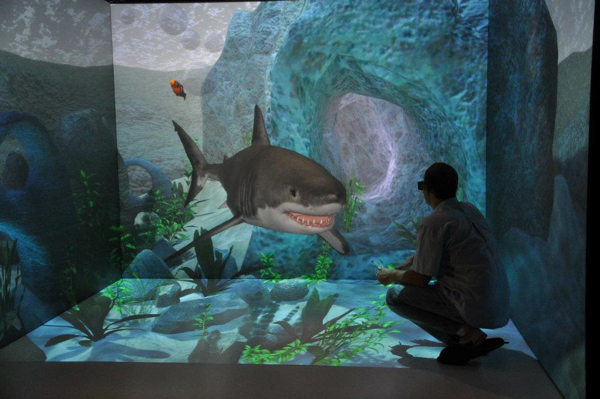[From CNBC]
[Image: Eon Reality’s virtual reality product, the Eon iCube.]
Virtual Reality Technology Comes of Age
Published: Tuesday, 27 Mar 2012
By: Joan Voight, Special to CNBC.com
Scuba diving among the sharks along Australia’s Great Barrier Reef is a breathtakingly immersive experience. It’s also dangerous and expensive.
But exploring a virtual ocean and coming nose to nose with a real-looking shark is a viable alternative. That, in a nutshell, has been the promise of virtual reality over the years — it could put us in an artificial environment that feels entirely real, without getting our feet wet.
Movies like “The Matrix,” “Lawnmower Man“ and “Star Trek“ gave us a taste of “VR.” In the mid-1990s startups and investors jostled to bring virtual technology to the mass market; instead, VR tech became specialized, used mostly in corporate training, the military (flight simulators) and science education.
No more. The success of the 3-D movie “Avatar” and the popularity of super-realistic video games are bringing virtual reality and its cousin, augmented reality, to the entertainment forefront.
You can now experience virtual reality technology at museums, discovery centers and trade shows and in immersive “rides” at Disney World and other big theme parks. It will soon make its way into our living rooms via devices that transport us fully into virtual games. And as the tech goes mainstream, the job opportunities are growing.
VR, also known as virtual entertainment, uses computers to create a simulated, three-dimensional world with which you interact; images seem life-sized, and your motions are tracked so the images change to reflect your change in perspective. In other words, it’s immersive.
Augmented reality, AR, rather than creating a made-up world, puts simulated or virtual images into the physical world. The real-looking bright yellow first-down line used in televised football games is a good example.
Meanwhile, electronic games and amusement parks are leading the way in entertainment VR. Motion and voice-sensing video-game devices like Nintendo‘s Wii remote control and Microsoft‘s Kinect sensors are combined with 3-D graphics to trick gamers into feeling that they are inside the action.
Video and computer games boasted more than $25 billion in sales in 2010, according to the Electronic Software Association.
“Virtual entertainment is changing from head-mounted displays and gloves to whole-body interaction, thanks to Wii and Kinect,” says Mike Goldstein, president of Amusitronix, which rents portable equipment for virtual experiences. “Now VR is more intuitive and easier for nontechies to use.”
Goldstein says virtual entertainment rentals hit a wall in the 2008 downturn. Annual sales at his Nanuet, N.Y., company sank from $2 million to $1 million. But business is now starting to see an uptick.
The outfit typically rents equipment at corporate and university events, trade shows and promotional tours. Thrill rides are always a hit, and the company is working on a new concept — flying-carpet trips above Paris and China.
For more sophisticated virtual entertainment, look to Walt Disney‘s theme parks and Comcast‘s Universal Studios, says Drew Davidson, director of the Entertainment Technology Center at Carnegie Mellon University.
“The Harry Potter Experience and the Spiderman ride at Universal Studios in Florida do a good job of exposing people to the new technology,” says Davidson. At Disney World, visitors experience VR tech in the DisneyQuest indoor interactive theme park.
EON Reality in Irvine, Calif., a short drive from Disneyland, has been quietly developing and selling virtual reality software for 13 years.
“When 3-D movies arrived at the local cinema, it [finally] became easier for people to grasp what our products do,” says Brita Kjallstrom, global marketing director.
Eon’s iCube is probably the best example of current VR capabilities, she says. The iCube consists of three to six walls in a 10-by-10-foot room with projectors aimed at each wall and a ceiling projector aimed at the floor.
Several PCs are synchronized to generate simultaneous images in stereo on multiple walls seamlessly. Inside, you wear glasses that track your movements. Images respond to your perspective as you move around.
Most of Eon’s sales are to corporations and universities, but its entertainment division also sells VR software and installations to museums, discovery centers and theme parks worldwide. Costs range from $995 for a basic software program to $1 million or more for a complete high-end installation, says Kjallstrom.
While full-fledged VR tech has yet to break into the home market, augmented reality “has comfortably snuggled into our world,” says Carnegie Mellon’s Davidson.
Today’s smartphones use AR components: a compass, GPS, camera and accelerometer. In the last two years, hundreds of mobile phone apps have incorporated AR technology.
An example, says Davidson, is the popular Seek ‘n Spell iPhone app in which a map of the real world on your phone is overlaid with virtual letters. You run around the physical world to gather virtual letters and accumulate points.
To grow further, all forms of virtual entertainment need more content creators, say experts. Building the hardware and software is only the beginning. The greatest demand is for high-tech animators and designers to provide compelling, ever-changing images and characters.
Jobs in virtual tech are found wherever video game, 3-D, and mobile app development is lively: Los Angeles; San Francisco; Seattle; Austin, Texas; Boston; North Carolina; and the Washington, D.C., metro area.
Much of the action is also happening overseas. Besides Southern California, Eon Reality has offices in Singapore and Sweden. Nintendo refers prospective employees to the DigiPen Institute of Technology located in Redmond, Wash., Singapore and Spain.
Virtual entertainment has not yet fulfilled its promise “of worlds spun completely from our imagination,” says Davidson. But breakthroughs in AR, gaming, filmmaking and corporate training are pushing it along.
“VR is barely in its teen years,” says one insider, “So there’s still a lot of growing to do.”
—
(Disclosure: Comcast owns 51 percent of NBC Universal, the parent company of CNBC.)
